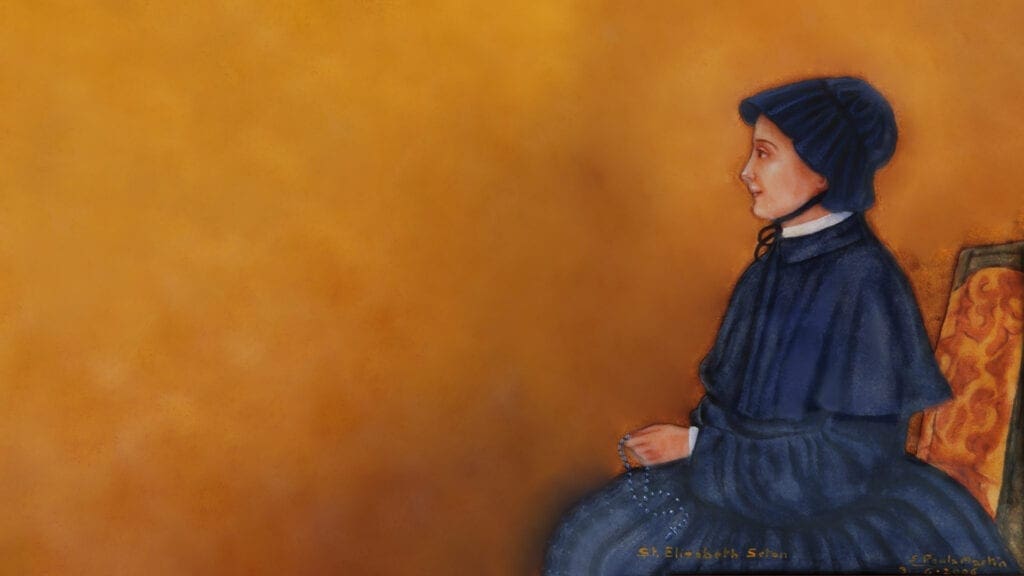
Elizabeth Ann Seton is the first canonized saint born in the USA. She was the foundress of the American Sisters of Charity and is credited as a pioneer Catholic educator who paved the way for the parochial school system in the United States.
| 1774, 28 August | birth |
| 1794, 25 January | married to William Magee Seton |
| 1803, 27 December | widowed |
| 1805, 14 March | made profession of Faith in the Catholic Church |
| 1809, 31 July | foundation of the Sisters of Charity of St. Joseph’s |
| 1810 | foundation ofSt. Joseph’s Free School & Academy for girls |
| 1821, 4 January | death inEmmitsburg, Maryland |
| 1963, 17 March | beatified by John XXIII |
| 1975, 14 September | canonized by Paul VI |
| 4 January | feast day |
Born in or near New York CityAugust 28, 1774, she was the daughter of Catherine Charlton and Dr. Richard Bayley, devout Episcopalians. She was baptized and grew to maturity in the Episcopal faith, which formed the foundation for her sanctity. Her father became the first public health officer of the Portof New York. She grew up in New York Cityand New Rochelle, New York. On January 25, 1794, she married William Magee Seton, the son of a wealthy shipping family and the new couple lived first in lower Manhattan. Their marriage was blessed with three daughters and two sons.
Early in their marriage, William became ill with tuberculosis. Elizabeth, William and their eldest daughter, Anna Maria, sailed to Italyin an effort to restore his health in a warmer climate but he died at PisaDecember 27, 1803, leaving her a widow with 5 young children when she was only 29 years old.Born in or near New York CityAugust 28, 1774, she was the daughter of Catherine Charlton and Dr. Richard Bayley, devout Episcopalians. She was baptized and grew to maturity in the Episcopal faith, which formed the foundation for her sanctity. Her father became the first public health officer of the Portof New York. She grew up in New York Cityand New Rochelle, New York. On January 25, 1794, she married William Magee Seton, the son of a wealthy shipping family and the new couple lived first in lower Manhattan. Their marriage was blessed with three daughters and two sons.
Close business and family friends–the Filicchi family of Livorno, Italy, provided warm hospitality and consolation. Always deeply spiritual, Elizabethwas impressed with their Catholic faith and devotions and began to inquire about their religion.
A year after her return to New York Cityshe became a Roman Catholic. This conversion cost Elizabethdearly. The next years were filled with much hardship: supporting five children, attempting to earn a livelihood as a penniless widow due to the bankruptcy of the shipping business before William’s death and lacking the support of family and friends.
In the summer of 1808, Fr William Louis Dubourg, a French émigré Sulpician priest from Maryland, met Elizabethwhile visiting New Yorkand invited her to come to Baltimorewith the promise of opening a school for girls there. She did so and remained on Paca Streetfor one year. There some women joined her with the intent of forming a community for apostolic service.
Through the generosity of a benefactor, Mrs. Seton relocated to rural Emmitsburg, Marylandand established Saint Joseph’s FreeSchooland Academy. This new work and way of life began July 31, 1809 in the Stone House in Saint Joseph’s Valley near Emmitsburg. It was successful and she was joined by more women thereby establishing the first community of religious women founded in America, the Sisters of Charity of Saint Joseph’s.
On January 17, 1812 the Regulations of the Sisters of Charity of St Joseph’s in the United Statesreceived official approbation. (These Rules were based on the Common Rules of the Daughters of Charity founded by Saint Vincent de Paul and Saint Louise de Marillac in Francein 1633). So was born the American Sisters of Charity which has grown into the Sisters of Charity Federation.
Elizabethsaw Christ in the poor, especially in women and children in need, even before being received in the Catholic Church. She is a Saint because of the way she searched for and responded to God’s will in her life.
Her holiness developed from her Episcopalian faith. She was a devoted communicant at Holy Trinity Episcopal Church and, prior to and after her conversion to Catholicism, she liked to spend time before the Blessed Sacrament in nearby St Peter’s Catholic Church.
Elizabethdied January 4, 1821 at the age of 46 in Emmitsburg, Maryland.
On March 25, 1850 the Emmitsburg Sisters of Charity of St Joseph’s joined the French Company of the Daughters of Charity of Saint Vincent de Paul.

